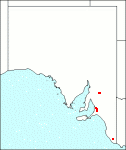Family: Poaceae
Danthonia tenuior
Citation:
Conert, Senekenberg. biol. 56:163 (1975). (111. Burbidge (1970) Australian grasses 3:pl. 50b.
Synonymy: Danthonia purpurascens Vick., Contr. N.S.W. natn. Herb. 1:301 (1950); Notodanthonia purpurascens (Vick.) Zotov, New Zealand J. Bot. 1:114 (1963); Plinthanthesis tenuior Steudel, Synops. Pl. glumac. 1:14 (1854); W. tenuior (Steudel)S.T. Blake, Contr. Qld Herb. 14:3 (1972); Rytidosperma tenuius (Steudel) A. Hansen & Sunding in Eriksson, A. Hansen & Sunding, Fl. Macronesia Checklist Vasc. Pl. pt 1, edn 2:93 (1979); D. semiannularis (Labill.) R. Br. var. browniana Domin, Biblthca bot. 85:363 (1915), partly.
Common name: None
Description:
Erect tufted perennial, 10-90 cm high; leaves flat at the base and becoming loosely inrolled, 1-3 mm wide, to 20 cm long, firm but not stiff and glabrous to hairy, with tubercle-based hairs 1-2 mm long; ligule shortly ciliate, with long hairs at the margins and on the collar, 1-5 mm long.
Panicles much exserted, lanceolate to ovate, spikelets 5-20 (usually c. 10) cm long; spikelets 4-6-flowered, the florets shorter than the glumes; glumes firm, with firmly membranous usually purplish margins, 10-17 mm long, subequal, 5-nerved; lemma lanceolate, 3.5-4 mm long (including the sparsely hairy callus of 1-1.5 mm); lower whorl of hairs exceeding the smooth shining glabrous or sparsely hairy back, whorl of hairs below the sinus c. 5 mm long; lateral lobes 7-10 mm long, with narrow membranous margins, narrowing evenly into the awns which are usually c. 2 mm long; central awn 9-12 mm long, loosely twisted in the lower part, exceeding the lateral lobes by c. 3 mm; palea oblanceolate to elliptic, 4-5 mm long distinctly exceeding the sinus by 1-1.5 mm, slightly hairy on the back; anthers 1-2 mm long, orange, pink, salmon-red or white.
|
|
Distribution:
|
Qld; N.S.W.; Vic.; Tas. New Zealand (introduced).
|
Conservation status:
native
Flowering time: Sept. — May.
|

SA Distribution Map based
on current data relating to
specimens held in the
State Herbarium of South Australia
|
Biology:
No text
Author:
Not yet available
|

